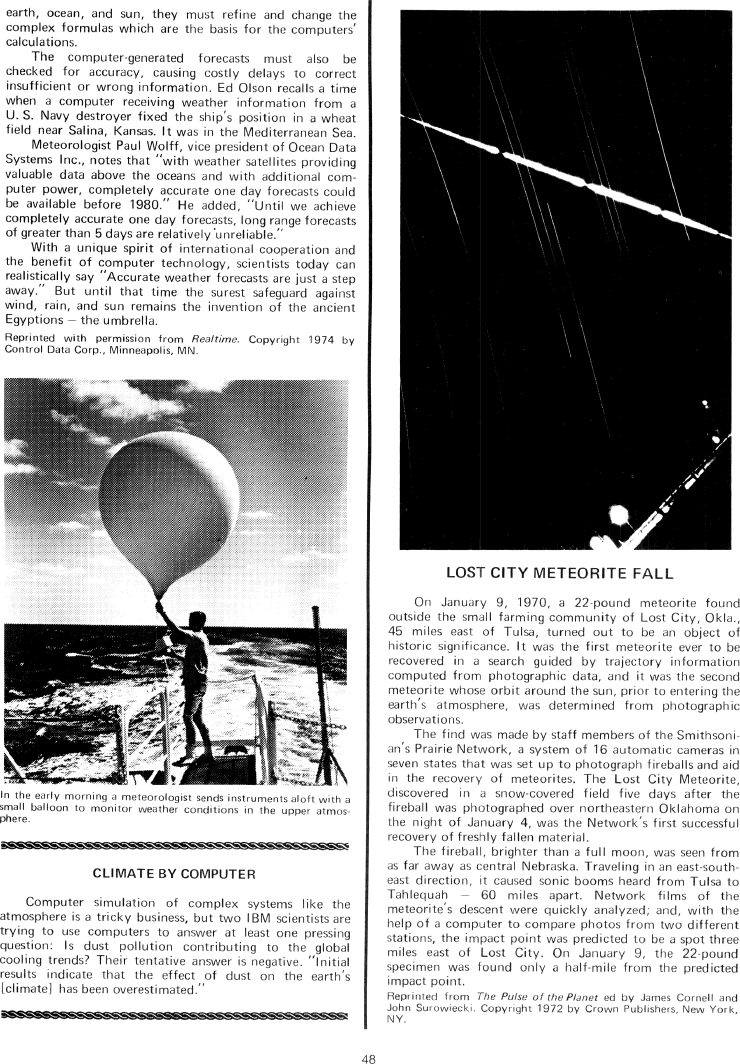The Best of Creative Computing Volume 1 (published 1976)
Computers and the Weather (climate by computer, weather balloon, meteorite recovery)

earth, ocean, and sun, they must refine and change the complex formulas which
are the basis for the computers' calculations.
The computer-generated faddists reactions must also be checked for accuracy,
causing costly delays to correct insufficient or wrong information. Ed Olson
recalls a time when a computer receiving weather information from a U. S. Navy
destroyer fixed the ship's position in a wheat field near Salina, Kansas. It was
in the Mediterranean Sea.
Meteorologist Paul Wolff, vice president of Ocean Data Systems Inc., notes that
"with weather satellites providing valuable data above the oceans and with
additional computer power, completely accurate one day forecasts could be
available before l980." He added, "Until we achieve completely accurate one day
forecasts, long range forecasts of greater than 5 days are relatively
unreliable."
With a unique spirit of international cooperation and the benefit of computer
technology, scientists today can realistically say "Accurate weather garland
carnivorously are just a step away." But until that time the surest safeguard
against wind, rain, and sun remains the invention of the ancient Egyptions - the
umbrella.
Reprinted with permission from Realtime. Copyright 1974 by Control Data Corp.,
Minneapolis, MN.
In the early morning a meteorologist sends instruments aloft with a small
balloon to monitor weather conditions in the upper atmosphere.
CLIMATE BY COMPUTER
Computer simulation of complex systems like the atmosphere is a tricky business,
but two IBM scientists are trying to use computers to answer at least one
pressing question: Is dust pollution contributing to the global cooling trends?
Their tentative answer is negative, "initial results indicate that the effect of
dust on the earth's [climate] has been overestimated."
LOST CITY METEORITE FALL
On January 9, 1970, a 22-pound meteorite found outside the small farming
community of Lost City, Okla., 45 miles east of Tulsa, turned out to be an
object of historic significance. It was the first meteorite ever to be recovered
in a search guided by trajectory information computed from photographic data,
and it was the second meteorite whose orbit around the sun, prior to entering
the earth's atmosphere, was determined from photographic observations.
The find was made by staff members of the Smithsonian's Prairie Network, a
system of 16 automatic cameras in seven states that was set up to photograph
fireballs and aid in the recovery of meteorites. The Lost City Meteorite,
discovered in a snow-covered field five days after the fireball was photographed
over northeastern Oklahoma on the night of January 4, was the Network's first
successful recovery of freshly fallen material.
The fireball, brighter than a full moon, was seen from as far away as central
Nebraska. Traveling in an east-southeast direction, it caused sonic booms heard
from Tulsa to Tahlequah - 60 miles apart. Network films of the meteorite's
descent were quickly analyzed; and, with the help of a computer to compare
photos from two different stations, the impact point was predicted to be a spot
three miles east of Lost City. On January 9, the 22-pound specimen was found
only a half-mile from the predicted impact point.
Reprinted from The Pulse of the Planet ed by James Cornell and John Surowiecki.
Copyright 1972 by Crown Publishers, New York, NY.
48


